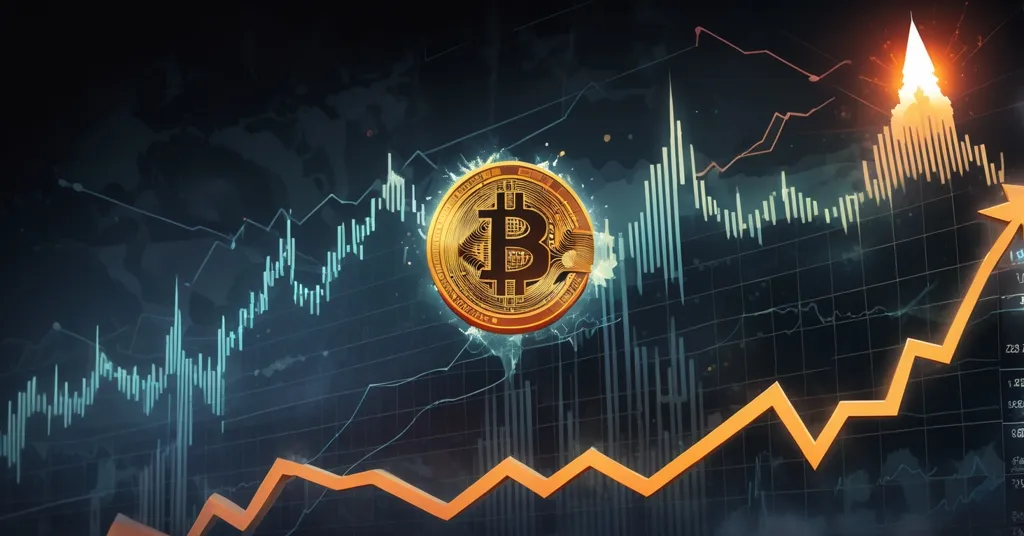Crypto Stocks Soar on Iran-Israel Ceasefire as New Tokens Spark Hype and Skepticism

Crypto Stocks Surge on Shaky Iran-Israel Ceasefire While New Projects Stir Hype and Doubt
A fragile ceasefire between Iran and Israel, brokered by the U.S., has sparked a sharp rally in crypto stocks, with heavyweights like Coinbase and Riot Platforms posting double-digit gains in a matter of hours. As geopolitical tensions take a brief pause, investor optimism has fueled risk-on behavior, while a handful of emerging crypto projects attempt to capitalize on the momentum with bold promises and speculative presales.
- Market Boost: Coinbase jumps 12.58%, Riot Platforms 8.09%, Marathon Digital Holdings 4.94% in a day.
- Geopolitical Shift: U.S.-mediated ceasefire holds after initial violations between Iran and Israel.
- Emerging Tokens: Snorter Token ($SNORT), Maple Finance ($SYRUP), and Bitcoin Hyper ($HYPER) pitch big returns.
Ceasefire Ignites Crypto Stocks Rally
On June 24, a ceasefire agreement between Iran and Israel, facilitated by the U.S. and Qatar, was announced, only to be shattered within an hour by Israeli missile strikes on Iranian nuclear sites, followed by swift retaliation. The chaos prompted a frustrated outburst from President Donald Trump, who played a central role in stabilizing the situation through diplomatic pressure and U.S. airstrikes.
“don’t know what the f**k they’re doing.”
Trump’s blunt assessment captured the initial defiance of both nations, but his intervention has, for now, held the truce together. This temporary calm has reverberated through financial markets, with crypto stocks emerging as unexpected beneficiaries. Coinbase, the leading U.S.-based cryptocurrency exchange, saw its stock soar by 12.58% in a single day. Mining giants Riot Platforms and Marathon Digital Holdings weren’t far behind, posting gains of 8.09% and 4.94%, respectively. Trading volume for Coinbase also spiked by roughly 15%, based on recent market trackers like CoinGecko, signaling retail investor enthusiasm—or perhaps just plain FOMO.
This rally isn’t a random fluke. Geopolitical de-escalation often triggers a shift toward riskier assets as investors move away from safe havens like gold or the U.S. dollar. We’ve seen this before—during the 2022 Ukraine crisis, crypto stocks like Coinbase gained nearly 10% in a week when peace talks gained traction. Bitcoin itself nudged up 3.2% to hover around $68,000 during this latest ceasefire, reinforcing its dual nature as both a speculative play and, at times, a hedge against chaos. For now, the market is betting on stability, but let’s not kid ourselves—a single misstep in the Middle East could flip this sentiment overnight.
Fragile Peace, Volatile Markets
The Iran-Israel truce is hanging by a thread, and crypto’s sensitivity to global events means this surge could be a flash in the pan. Bitcoin and its ecosystem often straddle a weird line: one day it’s digital gold, a refuge from fiat uncertainty; the next, it’s a high-risk asset dumped at the first sign of trouble. This ceasefire-driven rally mirrors broader trends where reduced tensions correlate with speculative investment, but history warns us to stay cautious. If missiles fly again, expect crypto stocks to tank as fast as they climbed, with investors fleeing back to traditional safe harbors.
Beyond geopolitics, other forces are at play in sustaining crypto market momentum. Institutional adoption, like the recent wave of Bitcoin ETF approvals, continues to bolster confidence in firms like Coinbase and Marathon Digital. Yet, the core of this space remains volatile—tied not just to global headlines but also to Bitcoin’s price action and regulatory whispers. As a Bitcoin maximalist, I see this as a reminder of BTC’s enduring relevance amid chaos, even if its role isn’t always crystal clear. The king of crypto still sets the tone, and these stock surges are as much about Bitcoin’s resilience as they are about a fleeting peace deal.
New Projects: Innovation or Just Hot Air?
While crypto stocks grab headlines, the underbelly of this space is buzzing with new projects riding the wave of investor optimism. Three tokens—Snorter Token ($SNORT), Maple Finance ($SYRUP), and Bitcoin Hyper ($HYPER)—are being touted as the next big thing, complete with presale hype and return projections that sound like they were cooked up by a carnival barker. Let’s dissect each with a skeptical eye, because while innovation excites me, bullshit does not.
First, there’s Snorter Token ($SNORT), a Telegram-based trading bot slated for a Q3 2025 launch, primarily on the Solana blockchain, with plans to support Ethereum Virtual Machine (EVM) chains later. For the unversed, Solana is a high-speed blockchain known for low fees and scalability, while EVM compatibility lets it play nice with Ethereum’s vast ecosystem. $SNORT promises trading fees as low as 0.85% for token holders, staking rewards with a staggering 260% APY (that’s your yearly return for locking up tokens), and governance rights. Its presale reportedly raised $1.2 million, with whale buys between $10K and $40K showing big-player interest. Priced around $0.0961 (though figures vary from $0.0935 to $0.1053), projections suggest a post-listing value of $0.94—an 879% return. Audits by SolidProof and Coinsult give some credibility, but the lack of transparency on its backer, Meme Studio LAB Limited, stinks of potential trouble. Telegram bots like Unibot soared in 2023 only to flop after hacks—$SNORT’s credibility needs to prove it’s not just another flash in the pan.
Next up is Maple Finance ($SYRUP), a decentralized corporate credit market running on Solana and Ethereum. If you’re new to decentralized finance (DeFi), think of it as banking without banks—lending and borrowing powered by blockchain. $SYRUP offers unsecured loans to businesses and yield for lenders, with full on-chain transparency (every deal visible on the blockchain ledger). Its token, priced around $0.60 on exchanges like Binance and MEXC, allegedly rose 18.16% since the ceasefire news. This taps into a real need—bridging crypto with corporate finance—but DeFi’s demons loom large. Smart contract bugs and regulatory heat, like the SEC’s ongoing war on crypto securities, could kneecap it. Picture a small business owner using $SYRUP for quick funds without a bank; it’s revolutionary, if it doesn’t get derailed by a hack or lawsuit first.
Finally, Bitcoin Hyper ($HYPER) pitches itself as a Layer 2 solution for Bitcoin, launching in Q3 2025 (though some reports say May). Layer 2 tech processes transactions off Bitcoin’s main chain to boost speed and cut costs, all while leveraging BTC’s rock-solid security. $HYPER uses the Solana Virtual Machine (SVM)—think of it as a turbocharged engine for blockchain speed—to enable faster transactions and decentralized apps (dApps) for Bitcoin. With a presale haul reported between $700K and $1.6 million, whale investments up to $74.9K, and a current price of $0.012025, it forecasts a post-listing spike to $0.32—a laughable 2,561% return—plus a staking APY of 481%. Audits by Coinsult and Spywolf check out, but team anonymity and shaky presale data raise glaring issues. As a Bitcoin maximalist, I’m curious—if it pulls off even half its promises, it could rival Lightning Network’s payment focus or Stacks’ smart contract play. But I’ll believe it when I see it after reviewing Bitcoin Hyper’s ambitious claims.
Navigating the Crypto Minefield
Let’s cut through the noise. The crypto stocks rally—Coinbase, Riot, Marathon—is a short-term win, a testament to Bitcoin and blockchain’s staying power amid global uncertainty. But it’s tethered to a geopolitical thread that could snap any second. Meanwhile, projects like $SNORT, $SYRUP, and $HYPER embody the experimental spirit of this space, pushing boundaries in trading, DeFi, and Bitcoin scalability. They reflect the effective accelerationism we stand for—driving tech forward at breakneck speed, obstacles be damned. Yet, the speculative drivel around returns (879%, 2,561%—give me a break) is the kind of garbage that burns newcomers. Over 80% of 2017-2018 ICOs flopped or scammed, per Statis Group data, and I’ve got no patience for FOMO-driven traps.
Here’s the flip side: there’s real potential if you squint hard enough. A Bitcoin Layer 2 like $HYPER, blending Solana’s speed with BTC’s security, could expand Bitcoin’s turf into dApps without diluting its core as decentralized money. DeFi players like $SYRUP might redefine corporate lending, assuming they dodge regulatory bullets akin to Ripple’s XRP mess. Even $SNORT, with Solana’s low-cost edge, could carve a niche—if it’s not just smoke and mirrors. As advocates for freedom and privacy, we cheer these experiments, but only with both eyes wide open. Do your own damn research: vet audits, hunt for team info, and never bet more than you can lose on unproven tokens after checking emerging crypto opportunities.
Bitcoin remains king for a reason—its battle-tested decentralization and security outshine altcoin pipe dreams. Still, I’ll concede that Solana, Ethereum, and niche players fill gaps BTC doesn’t touch, from fast trades to complex finance. This ceasefire rally and presale buzz are snapshots of a volatile, innovative space—one we’re hell-bent on accelerating responsibly. Weigh the hype against hard facts; our revolution thrives on skepticism as much as it does on vision. Stack sats, stay sharp, and don’t get suckered by the next shiny thing without digging deep into analyses like those on scaling Bitcoin with Layer 2 tech, discussions on Riot Platforms’ performance, or insights into crypto price drivers during geopolitical shifts.
Key Takeaways and Questions to Ponder
- How does geopolitical stability affect cryptocurrency markets?
Stability, like the Iran-Israel ceasefire, fuels risk-on sentiment, driving capital into crypto stocks—evident in Coinbase’s 12.58% surge. Investors pivot from safe havens to speculative assets, though this can reverse instantly if tensions escalate. - What are the dangers of investing in presale tokens like $SNORT and $HYPER?
Presale tokens carry huge risks—unproven teams, speculative returns (like $HYPER’s 2,561% projection), and a history of scams. Many projects fail or crash post-listing, so extreme caution and thorough research are mandatory. - Why are Layer 2 solutions like Bitcoin Hyper vital for Bitcoin’s future?
Layer 2 tech addresses Bitcoin’s slow speeds and high fees by handling transactions off-chain while keeping security intact. $HYPER could enable dApps and broader use cases, potentially making BTC more than digital gold. - How trustworthy are massive return predictions for new tokens?
Forecasts like $SNORT’s 879% or $HYPER’s 2,561% gains are often pure hype, lacking solid backing. Most collapse under post-listing sell-offs, so treat them as fiction until market adoption proves otherwise. - What unique value do DeFi platforms like Maple Finance offer?
DeFi projects like $SYRUP disrupt traditional finance with decentralized lending and borrowing, offering transparent corporate credit on-chain. They push financial inclusion but face hurdles from hacks and tightening regulations. - How does Bitcoin fare during geopolitical uncertainty compared to stocks?
Bitcoin often acts as both a safe haven and risk asset, ticking up 3.2% during this ceasefire while stocks like Coinbase surged higher. Its resilience shines, though it’s not immune to sharp drops if crises worsen. - What should investors prioritize when evaluating presale tokens?
Focus on team transparency, audit quality, and project utility over hyped returns. Check for public data on developers, verified smart contracts, and realistic roadmaps to avoid falling for scams or doomed ventures.



